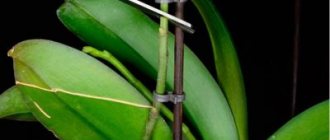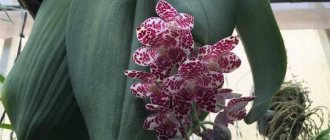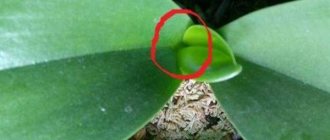What is a peduncle
Peduncles in orchids are shoots that form from below on the above-ground part and grow upward. After the formation of a peduncle, flowers bloom on it. When the arrow just begins its formation, it is easy to confuse it with the roots or children of the epiphyte, since there are very few differences. Therefore, it is important to be able to distinguish the peduncle from the root of a phalaenopsis or its offspring.
To distinguish the peduncle of an orchid from the root and children, pay attention to the following signs:
- the roots have a rounded shape, and the flower arrows are cone-shaped;
- a flower arrow can be distinguished from a basal arrow after a while, when it grows a little, the shape of its tip becomes like a boat;
- the central vein of the leaf becomes the place of formation of the flower arrow;
- usually the arrow forms in the same place where there was flowering before;
- The main difference between the peduncle and other parts of the plant are the buds that bloom on it after final formation.
The flower stem at any stage of development is covered with irregularities in the form of scales or small spines. They are dormant buds.
It is the peduncle that is responsible for the beauty of the orchid. After all, over time, buds form and flowers bloom on it. In its upper part there is a green tip, which represents a growth point. As long as it is alive, new flowers will appear on the stem.
How does it begin to open up?
In the axils, between the leaves, on the stem of the plant, there are dormant buds, which, under conditions close to natural (with normal care), can develop into a peduncle or give off lateral shoots. Sometimes inexperienced gardeners confuse flower stalks with aerial roots.
It should be remembered that the flower-bearing arrow always develops from the growth point. The peduncle can bend bizarrely at the beginning, and then stretch out quite high. At the top of the flower-bearing arrow, bulbs are formed, which subsequently open into beautiful delicate buds.
Important! During the formation of the peduncle, under no circumstances should the Orchid be subjected to stress.
In the case of the simultaneous appearance of a peduncle and a new leaf, it is best not to interfere and let the plant independently choose what is best for it to develop.
Care before the appearance of the peduncle of the orchid and during the growth period
Until an arrow appears on the epiphyte, cultivation is carried out according to standard rules. The flower is provided with diffused lighting. To do this, it is moved from the southern window sill in mid-spring. Water the plant so that the soil dries out for several days between irrigations. This will enable the root system to take part in the process of photosynthesis.
The plant is provided with an influx of fresh air and at the same time protected from drafts. Cold is especially dangerous for orchids in winter. Damaged parts cannot be healed. Therefore, frozen tissues are cut out. Air humidity in the room is maintained at least 65%. During this period, the flower is regularly fed with special fertilizers marked “For orchids.” Others are not suitable for epiphytes because they burn the root system.
During the formation of the flower arrow, the care of the epiphyte changes. Therefore, it is important to know how to care for an orchid when it has released a peduncle.
After the orchid has a peduncle, irrigation is reduced. But at the same time, the flower is not subjected to overdrying. To do this, increase the interval between watering for drying to 5 days instead of 2-3 under the usual cultivation regime. Then the orchid is watered not once a week, but twice a month.
While the orchid’s peduncle is growing, the addition of nutrients is reduced. Fertilizing is completely abandoned when the plant begins to form buds. If this is not done, flowering will be short.
If the orchid has put out an arrow in the fall or winter, the pot is moved to the south side. If this is not possible, additional lighting will be provided. Otherwise, the shoot will stop developing. For good development, the arrows maintain the air temperature in the room from +23 to +26 degrees. Lower temperatures reduce the growth rate and cause the arrow to dry out.
Important!
The number, size and color of the buds largely depend on how carefully the plant was cared for in the last 120 days before the formation of the stem. If fertilizing is applied only at the moment the peduncle appears, there will be no abundant flowering.
The plant has sprung up: what to do next?
Selecting a location
Now that the plant has thrown out its peduncle, the pot with the orchid must be moved to the eastern or western windowsill, since it is light there and there is no influence of aggressive sunlight. If there is only one window in the apartment, and it also faces the south side of the house, then only shading can save the plant from burns and other problems.
Temperature
In apartment conditions, caring for orchids is simple in terms of maintaining temperature conditions. The house is always quite warm, but there are two dangerous moments :
- Air conditioning , which dries the air sharply and after operating the device it is necessary to additionally spray the plant.
- Draft . Orchids do not tolerate hypothermia. This means that you should remove the pots from the windowsill while ventilating the room.
In the event that the orchid has become capricious and has ceased to delight us with its beautiful blooms, we will create a little stress for it. To do this, we will lower the daytime temperature to +12 °C, and lower the nighttime level by another couple of degrees.
This method is for activating bud formation in a plant. Having discovered their appearance, there is no need to dramatically change the established regime. You should gradually get used to the usual room regime so that the buds get stronger and soon move into the budding stage.
Air humidity
It is necessary to maintain a tropical level of room humidity of about 65% . In apartment living conditions, this figure is much lower, especially during the heating season.
Frequent spraying from a spray bottle helps to maintain a microclimate favorable for the orchid; every other day is quite enough. The water should be well settled and correspond to room temperature.
Proper lighting
In the summer season, it is better not to display the flower on a bright sunny windowsill. Otherwise, burns cannot be avoided. It is better for the light to be diffused. During winter and autumn twilight, special lighting is required. Otherwise, the foliage of the flower will begin to turn yellow and the buds will not open.
In order to compensate for the lack of sunlight, it is enough for one flower to turn on a 40 W light bulb, installed so that a sufficient amount of light falls on the leaf and inflorescences.
Watering
When there is a low level of humidity in the room, then the plant will begin to release most of the moisture through the leaves. The soil should be moistened more often. Irrigation tactics - drying and watering, that's what you need. Soil conditions should be continually assessed. If you cover the top of the soil with moss, moisture will be retained longer . You can give the flower a systematic warm shower or immerse the flowerpot in a container of water for 40 minutes once every 10 days.
Top dressing
Flower care measures include the addition of mineral compounds containing potassium and phosphorus. The procedure is performed once a month, according to the instructions.
While the growth of the peduncle continues and during the flowering period, the orchids stop fertilizing. After all, any fertilizing affects the reduction of its budding time.
Growth Characteristics
In ordinary phalaenopsis, the peduncle grows for 2 months. Hybrid varieties produce flower stalks longer. Their formation period takes 3 months. During this time, the newly hatched stem turns into a full-fledged arrow. Depending on the growth conditions of the Phalaenopsis orchid, the interval may increase or decrease.
When provided with the right amount of light, sufficient humidity, warmth and nutrients, the growth process is 2 times faster. The side stems grow even faster and are fully formed in 1.5 months.
Typically, an orchid produces 2 to 3 flower stems. Sometimes in florist shops you can find plants with a lot of arrows. At home, the number of flower stalks is determined by the growing conditions of the plant and its care.
After the orchid shoots, it is important that it grows evenly and looks beautiful during flowering. To do this, perform the following steps:
- When the arrow grows to a length of 20 cm and is strong, it is fixed vertically.
- An orchid with a peduncle must be tied to a support using a special clothespin. If you don’t have one, use a regular hair tie or crab clips.
- If it is impossible to tie the flower stem, the pot is regularly unfolded as the arrow develops. Then it will reach out to the light and grow in the right direction.
If the arrow is broken
Sometimes the arrow breaks. This process, of course, is unpleasant, but there is no need to panic too much. First you need to determine the cause of what happened.
Why might it break off?
It has already been said that the peduncle of an orchid in indoor conditions can grow up to 1 meter. Of course, such a sprout can break for many reasons:
- it needs support, which you did not take care of, stick a small but strong stick next to the flower;
- There are frequent cases of mechanical injury when moving a pot with a plant;
- a weakened flower is vulnerable, feed it better;
- A drying peduncle can break; the signs and causes of this phenomenon have already been discussed above.
Precautions to avoid breaking
They are easy to follow:
- make sure that the flower has something to lean on;
- do not move it unnecessarily;
- be careful when watering and fertilizing;
- Keep pets away from the plant.
If a fracture does occur, do not restore the broken part with a plaster or tape. It is better to carefully cut off the top part and place it in water. If there are buds left on it, they will bloom after some time.
IMPORTANT! In water, the buds can still open and bloom for some time - up to 2 months.
The same can be done with a flowering plant. Only the container with water should be shaded, otherwise algae will quickly appear there.
How to prevent a stop in the development of the arrow
When a flower stalk appears on the plant, it is important to create comfortable conditions. Then the arrow will constantly develop and will not stop developing. To do this, it is important to ensure that the lighting does not decrease. If the length of daylight hours has decreased, additional illumination with phyto-paws is organized.
Waterings are gradually reduced and the interval between them is increased. It is important not to overdry the plant. The temperature in the room is maintained at the optimal level for good growing season. Fertilizers are applied on time in accordance with the attached instructions.
How to stimulate the appearance
The best time is when orchids release their magnificent flowers. But it often happens that you have to wait a long time for this period. Therefore, if the plant does not bloom for a long time, then stimulation of the flowering shoot can be undertaken. This simple procedure includes several techniques. It should be noted that a flower cannot be transferred to the flowering phase if a comfortable temperature regime is not created.
All flower growers enjoy the flowering period, but not everyone knows how to force an orchid to produce a flower stalk. In order for a plant to expel a flowering shoot, it needs to be subjected to a little stress. For example, create conditions for the onset of an artificial drought. To do this, reduce the number of waterings or stop watering altogether after flowering. You can also create sudden changes in temperature. All these processes are best carried out in winter.
How to make phalaenopsis shoot arrows at the same time
Usually an orchid produces only one arrow on which flowers form. You can grow several flower stalks only on an adult plant that has from 8 to 10 leaves in a rosette. Such an orchid often produces 2-3 flower stems, but it is not capable of throwing out more than three.
By expelling several flower arrows, the plant is stressed. Then, after abundant flowering, the orchid will begin to hurt, and it will develop a loss of strength. Therefore, experienced gardeners do not advise artificially stimulating the plant to form more than two stems.
What to do to:
Has the arrow stopped developing?
In order for the arrow to grow and not slow down its growth, you need to monitor the basic parameters of care :
- Lighting - if it has decreased due to natural reasons, it is necessary to introduce additional lighting using special lamps for plants;
In order for the flowering arrow to grow well, all care conditions must be observed. - Watering should be reduced compared to the usual regime. But you shouldn’t dry the flower to a desert state;
- The temperature must be within the range necessary for the vegetative growth of the plant;
- Don’t forget to apply fertilizers on time and according to all the rules.
By following these rules, the plant will definitely delight its grower with beautiful tropical flowers .
Did the orchid produce several flower stalks at the same time?
How to make an orchid produce several flower stalks? will not produce more than 3 flower stalks . More often, one shoot is produced, on which flowers bloom.
But if the flower is old enough and has 8-10 leaves in the rosette, then there is a possibility of 2-3 flower stalks appearing.
But this is stress for the plant and sometimes after such abundant flowering there is a loss of strength in orchid plants. But in our conditions, which are often created even by experienced flower growers, more than 2 peduncles do not appear on flowers .
Possible problems
Sometimes the peduncle of an epiphyte does not grow for a long time or the arrow has grown incorrectly. Often, flower growers with little experience break the flower stem. In this case, you need to understand the cause of the problem and determine actions to solve it.
Variant of the norm
The drying process means a loss of rigidity and elasticity of the peduncle. In this case, the first thing that changes is its appearance. The green color gradually fades. The peduncle becomes brown, then purple. The dried part of the plant stops absorbing moisture. In the damaged area, photosynthesis stops and death gradually occurs. In fact, this is a normal process. If the orchid peduncle begins to turn yellow after flowering, there is nothing to worry about. The flowers simply withered and the peduncle became unnecessary.
Things are worse if the peduncle dries out, and at the same time buds form on it. In this case, the flowers simply have no chance to please you with their beautiful corollas. Then there are reasons to think and analyze the conditions in which the orchid grows. It wouldn’t hurt to review the rules of care.
Actions after flowering is completed
When the flowering period ends, caring for the flower depends on the condition of the flower stem. If the shoot turns yellow and shows signs of drying, it is cut off at the very base. The resulting wound is sprinkled with crushed charcoal or ground cinnamon to prevent infection. You can use chalk for the same purpose.
When the stem itself is green and the apical bud has dried up, the stem is shortened. The cut is made slightly above the first living bud. Exposed fabrics are treated with cinnamon, charcoal or chalk for disinfection.
If there are no signs of wilting or drying on the stem, it stands green, with healthy buds. After the end of the dormant period, buds will again form on such a stem and flowers will bloom. Therefore, you don't need to do anything with it.
When can a plant not sprout and what to do?
Sometimes you seem to be doing everything correctly, but the flower persistently does not grow. You should pay attention to the correct care and urgently correct your mistakes.
Root rotting
With excessive watering or irrigation with cold water, root rot occurs.
- This situation can be easily corrected if a small area of the plant is affected. Simply remove it with a sharp knife and process the cuts.
- When the root system rots extensively, resuscitation procedures must be carried out. First of all, remove all black and watery roots, process the cuts, and leave the orchid to build up the root mass.
Yellowing of leaves
The leaf may turn yellow for various reasons:
- Incorrect watering.
- Too sunny place.
- Oversaturation with fertilizers.
- Lack of root system for various reasons.
- Adaptation of a plant to its environment.
- Natural wilting of a flower.
No flowering
- The plant may not bloom due to a lack of mineral composition for its growth.
- Due to the lack of diffused sunlight.
Harmful insects
In addition to the general signs of infection, the orchid is often damaged by harmful insects:
- Spider mites . Minor gray dots appear on the visible part of the roots, shoots, and foliage. The leaf plate is entangled with a cobweb.
- Whitefly . A sticky coating is visible on the leaf - honeydew. Balls called “cocoons” are found on the soil in the pot.
- Sucking parasites living in large colonies (scale insects, aphids, scale insects) . Flowers and foliage curl and turn yellow, with sticky mucus appearing on them.
- Thrips . The bottom of the leaf turns yellow, there are a lot of tiny dark inclusions on it - traces of excrement.
- Woodlice . They violate the growth point. Small holes appear on the buds and leaves.
- Fool . The pest, which damages the young root system, only appears in excessively wet and acidic soil. Damages young roots.
- A rare harmful insect for domestic orchids is the cricket ; it leaves holes on the flower and buds and eats the roots.
When trying to save a sick orchid, you should follow some tips:
- Remove healthy plants from the infected area.
- Do not touch a healthy area of a disease-affected plant, so as not to spread the disease throughout the entire area of the plant.
- After eliminating the diseased parts with a sharp knife, you need to apply a fungicide to protect the remaining healthy tissue.
- For this purpose, you can use cinnamon; it, when ground, can be applied to the area where the infected areas were cut out.
- An alcohol solution is a good tool for combating harmful insects hiding in the shells and crevices of foliage.
- The next method to combat black fungus is to spray a solution of laundry soap.
- Replacing the substrate in the orchid pot will eliminate mold.
In order for the plant to acclimatize and grow well, appropriate competent care should be provided to it. Then, following the growth of foliage, the long-awaited period of flowering will come, to the delight of the gardener!
Orchid awakening period
Any plant has a period when it needs rest. Typically this process occurs after flowering. In orchids, the dormant period is either pronounced or not at all. If in natural conditions awakening begins with the arrival of warm weather and heavy rainfall , then at home it is quite difficult to create a natural climate.
It is biological or forced reasons that are the determining factors in the severity of dormancy and awakening of the plant.
Warmth and the supply of moisture with nutrients provoke active activity of the root system , which stimulates the formation of new life - the awakening of a dormant bud, and from it - a peduncle or children.
Therefore, the main period of awakening is considered to be the spring season , accompanied by an increase in ambient temperature.
Why is it important to be able to distinguish between the peduncle and other parts of the plant?
The appearance of a generative shoot on a plant means its transition to a new stage of development - flowering, which generally marks the beginning of a productive period in the life of the plant organism. At this time, he needs more water and light. The appearance of an arrow also indicates that no more fertilizer is required. Flowering is the period when the nutrients accumulated by the plant are released.
Note! Fertilizing and feeding Orchids is carried out in the period before flowering. After a shoot with buds has formed, they are stopped.
How to distinguish a peduncle from a root
The root tip has a uniform tissue - a growth cone with a light color, smooth, without scales. The task of the root is to provide the plant with moisture and substances for growth. Therefore, as the root lengthens, it rushes down, it tries to grow inside the airy-stony substrate.
In addition, the root performs the supporting functions of the plant in space. Orchids have long flower stalks, many reaching a length of 0.5 m or more. Powerful flowers thus strengthen their support by forming many additional roots from the stem. The absence of additional roots may indicate a lack of nutrients and light.
From the very moment of their formation, flower stalks carry the rudiments of buds, so they have a pointed tip, followed by green scales - the rudiments of flowers. The direction of growth of a generative shoot can be varied, but most often it is oriented towards the light source and upward.
Flowering periods of the three most common varieties
Cymbidium
The most popular type of orchid, which increasingly occupies a comfortable place in the homes of lovers of beauty. These specimens are easy to care for , which is why they are in great demand.
Cymbidium blooms from October to February , and also, with proper care, from July to October.
Cymbidium.
Phalaenopsis
The best option for those who are just mastering floriculture. Phalaenopsis does not require scrupulous care. And this species has won the love of millions because it is able to bloom all year round.
Phalaenopsis.
Dendrobium
Dendrobium is one of the tallest orchids; it has long settled in homes as a houseplant. The main flowering time is from October to January .
With proper care, flowering is possible from July to September.
Dendrobium.
How to properly feed phalaenopsis with garlic water
After soaking, the orchid is placed in a warm place so that excess moisture dries out faster.
The prepared solution is a fairly strong concentration. Comrades, it would be very reckless to work with them on dry orchid roots. Therefore, the preparatory stage is major watering of phalaenopsis in the usual way.
Immediately after this, the pot is immersed in garlic water for 30 minutes. It should cover half to two thirds of the bark
. It is very convenient to use a slightly larger pot without holes in the bottom, a narrow bowl, a mayonnaise bucket or a cut-off 5-liter drinking water bottle as a “jacuzzi.”
Step-by-step instructions: what to do in a certain situation?
Let's consider what to do if the peduncle that grows from the growth point breaks or other possible cases:
- Grows from a growing point. This happens if the phalaenopsis has already undergone many flowering cycles or has experienced severe stress. In this case, you don’t need to take any action, you just need to take care of the plant and, perhaps, buds or babies will appear on the arrow.
- Broken. In this case, you need to cut the peduncle to the bud located closest to the fracture site and treat the cut site with crushed activated carbon, wood ash or cinnamon powder.
Important! You should not try to glue or connect the fragments in any other way - this will only harm the flower. - Absent at all (you can find out why phalaenopsis does not bloom and how to correct the situation here). You can stimulate the flowering stalk by arranging a slight stressful situation for the plant. To do this, you can, for example, slightly limit the access of light to the flower or water it less often. Of course, it is impossible to bring things to a complete drought. If possible, you can lower the air temperature at night by 5-6 degrees.
- Stopped growing. To begin with, it is necessary to exclude disease or the presence of pests from the list of possible causes. After making sure that the flower is healthy, you should once again reconsider the care of the plant and make sure that it has enough nutrients and moisture, enough light, and that the temperature and humidity levels are comfortable. If the phalaenopsis is not sick and the conditions for keeping it are suitable, but the peduncle still does not grow, you can only wait - if the arrow has not dried out, the orchid can still bloom.
Basic Rules
You must know the basic rules of pruning in order to minimize injury to the plant.
First you need to pay attention to the selection of devices that you cannot do without. These include:
- Garden pruning shears are the best option, as they do not injure the stem when pruning. You can replace it with sharp scissors or a knife, but you need to act carefully.
- Alcohol or other disinfectant (you can use bleach or the boiling method). They need to treat the tool before cutting.
Next you need to determine the cut point:
- If it is a peduncle (peduncle), then you need to trim it above the dormant bud at a height of one or two centimeters. Moreover, the closer the bud is to the leaf rosette, the more flowers will be formed on the later lateral shoot. However, re-blooming should be expected no earlier than two to three months after pruning.
- If it is an aerial root (rotten or completely rotten, frozen, dry, dying), then pruning is done to include one or two centimeters of healthy tissue. Remember that in this case you will also need to transplant the plant into a suitable pot with fresh substrate.
- If it is a leaf (dry, diseased, frozen, yellowed, swollen, etc.), then pruning is done so as to capture about two centimeters of healthy tissue.
Next, you need to process the cut area. Crushed activated carbon, ground cinnamon, brilliant green or iodine are suitable for this. Any of these products is an excellent antiseptic that disinfects. Then the treated cut area must be dried for at least twenty minutes.











